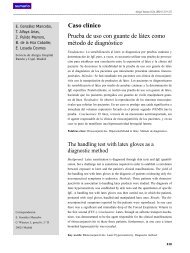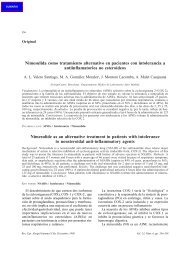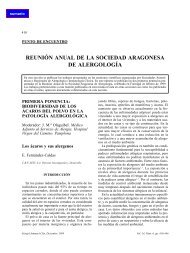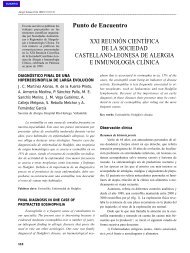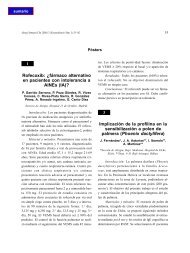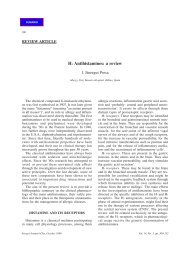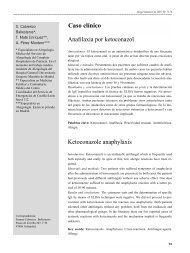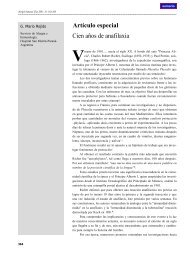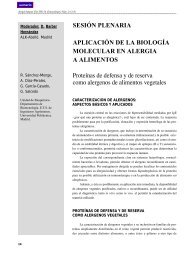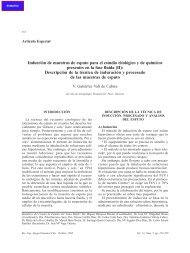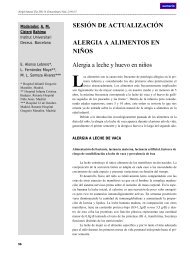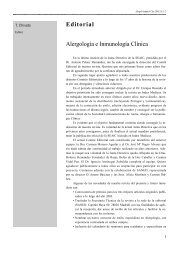Ficus benjamina, a new source of household environmental allergens
Ficus benjamina, a new source of household environmental allergens
Ficus benjamina, a new source of household environmental allergens
Create successful ePaper yourself
Turn your PDF publications into a flip-book with our unique Google optimized e-Paper software.
Non-pollinating ornamental plants have been<br />
achieving increasing importance over the last few<br />
years as <strong>source</strong>s <strong>of</strong> <strong>allergens</strong> capable <strong>of</strong> inducing<br />
both occupational 1-9 and non-occupational 10-12 respiratory<br />
allergy. Among such plants, the species<br />
<strong>Ficus</strong> <strong>benjamina</strong> (also known as "weeping fig") is<br />
one <strong>of</strong> the foremost.<br />
BOTANICAL CHARACTERISTIC OF FICUS<br />
The genus <strong>Ficus</strong> belongs to the order Urticales,<br />
family Moraceae, and has about 1000 species.<br />
Most <strong>of</strong> these species are trees and many <strong>of</strong> them<br />
achieve great sizes in the tropical regions where<br />
they mostly originate; however, when cultivated<br />
in our temperate latitudes, their proportions are<br />
more modest. In their original environment, the<br />
crown <strong>of</strong> some species attains very considerable<br />
extension. There is for instance one <strong>Ficus</strong> in the<br />
Andhara valley in India, the crown <strong>of</strong> which has a<br />
perimeter <strong>of</strong> over 600 meters and is supported by<br />
over 300 aerial roots. The emission <strong>of</strong> such aerial<br />
roots is arguably the most noteworthy characteristic<br />
<strong>of</strong> this botanical genus. They originate from<br />
the branches and grow downwards to the soil,<br />
which they penetrate like any other root; they thus<br />
serve as a support for the crown, which may<br />
therefore grow and attain the already stated<br />
dimensions. This does not occur in our climate,<br />
and the emission <strong>of</strong> aerial roots is rather scarce<br />
and restricted to some trees <strong>of</strong> rather advanced<br />
age, although this phenomenon can be clearly<br />
observed in the climate <strong>of</strong> the Canary Islands.<br />
Beyond this curious characteristic, the <strong>Ficus</strong><br />
share other particular features: the presence <strong>of</strong> a<br />
milky sap (latex); having rigid, <strong>of</strong>ten large sized<br />
leaves, and a characteristic fruit termed sycone or<br />
"fig", which is actually not a fruit but an infrutescence<br />
comprising a large number <strong>of</strong> very small<br />
fruitlets enclosed in a fleshy receptacle.<br />
The best-known <strong>Ficus</strong> species is the "common<br />
fig tree" or <strong>Ficus</strong> carica, cultivated because <strong>of</strong> its<br />
fruits since long before the time <strong>of</strong> Jesus Christ<br />
<strong>Ficus</strong> <strong>benjamina</strong>, a <strong>new</strong> <strong>source</strong><br />
<strong>of</strong> <strong>household</strong> <strong>environmental</strong> <strong>allergens</strong><br />
Alergol Inmunol Clin, July 1999 Vol. 14, No. 4, pp. 203-208<br />
203<br />
EDITORIAL<br />
and today quite widely distributed. Among the<br />
<strong>Ficus</strong> species grown only for ornamental purposes,<br />
there are some which are used as indoors<br />
decorative plants, such as <strong>Ficus</strong> <strong>benjamina</strong>, <strong>Ficus</strong><br />
cyathistipula, <strong>Ficus</strong> deltoidea, <strong>Ficus</strong> elastica,<br />
<strong>Ficus</strong> lyrata, <strong>Ficus</strong> microcarpa (F. nitida), <strong>Ficus</strong><br />
parcellii, <strong>Ficus</strong> pumila, <strong>Ficus</strong> rubiginosa (F. australis)<br />
and <strong>Ficus</strong> sagittata (F. radicans).<br />
Other <strong>Ficus</strong> species are commonly used in<br />
Spain as decorative outdoor plants in gardens<br />
and/or promenades in areas where the climate<br />
allow it, such as the Levant, Andalusia and the<br />
Canary Islands; the commonest among these are<br />
<strong>Ficus</strong> altissima, <strong>Ficus</strong> benghalensis, <strong>Ficus</strong><br />
macrophylla and <strong>Ficus</strong> religiosa.<br />
Among the indoor <strong>Ficus</strong> species, one <strong>of</strong> the<br />
most widely used is <strong>Ficus</strong> <strong>benjamina</strong>. This is a<br />
shrub or small tree, which may attain 1.5 - 2<br />
metres, with drooping branches and some 1800<br />
small, oval, pointed and hanging leaves. Its area<br />
<strong>of</strong> origin is India and Malaysia, and since some<br />
years ago it has become one <strong>of</strong> the most used<br />
indoor plants both in <strong>household</strong>s and in <strong>of</strong>fices,<br />
due to the fact that it requires almost no care 13 .<br />
OCCUPATIONAL RHINITIS AND ASTHMA<br />
DUE TO FICUS BENJAMINA<br />
The first scientific report on the allergenicity <strong>of</strong><br />
<strong>Ficus</strong> species was published by the Swedish physician<br />
G. Axelsson, who in 1985 described two<br />
patients, one <strong>of</strong> them with asthma and the other<br />
with allergic rhinitis. Both patients were occupied<br />
in the care <strong>of</strong> indoor plants, and in both <strong>of</strong> them<br />
the symptoms were clearly triggered when they<br />
energetically shook <strong>Ficus</strong> <strong>benjamina</strong> in order to<br />
get rid <strong>of</strong> the dust deposited on their leaves. Both<br />
patients evidenced positive skin tests and RAST<br />
with an extract <strong>of</strong> leaves and an extract <strong>of</strong> stems<br />
<strong>of</strong> <strong>Ficus</strong> <strong>benjamina</strong> 14 .<br />
Companies dedicated to gardening and plant<br />
care services for <strong>of</strong>fices, including rental and<br />
maintenance <strong>of</strong> plants, have become increasingly
204 J. Subiza Volume 14<br />
important in Stockholm in recent times. In 1985,<br />
about 100 people were already employed in the<br />
daily cleaning <strong>of</strong> <strong>of</strong>fice <strong>Ficus</strong> (plant caretakers).<br />
Axelsson and co-workers were able to study 52<br />
such plant caretakers and found that 30% <strong>of</strong> them<br />
evidenced IgE mediated sensitization to <strong>Ficus</strong><br />
<strong>benjamina</strong>, which caused occupational rhinoconjunctivitis<br />
in 100% <strong>of</strong> the cases and added occupational<br />
asthma in 37%. 87% <strong>of</strong> the sensitized<br />
workers also suffered localized contact urticaria<br />
upon contact with latex from F. <strong>benjamina</strong>. Atopy<br />
did not appear to be a predisposing factor, as 61%<br />
<strong>of</strong> these cases were not atopic. The degree <strong>of</strong><br />
exposure, however, was indeed a predisposing<br />
factor, as the prevalence <strong>of</strong> <strong>Ficus</strong> sensitization<br />
among 16 workers (commercial agents, florists<br />
and executives from these companies) who only<br />
on occasion worked with this plant was as low as<br />
11% 1 .<br />
According to these investigators, the mechanism<br />
probably involved in the sensitization is as<br />
follows: the <strong>allergens</strong> emanate from the latex <strong>of</strong><br />
the plant, and it is the water diffusing from the<br />
plant interior to the surface (a diffusion phenomenon<br />
favoured by the hot and dry air in <strong>of</strong>fice<br />
environments) which osmotically carries the latex<br />
<strong>allergens</strong> to the exterior <strong>of</strong> the leaves. This solution<br />
soaks the dust particles present on the leaves,<br />
and these particles, when dry, become aerosolised<br />
into the air and behave as pneumo<strong>allergens</strong>. Several<br />
data lend support to this possible mechanism:<br />
(A) The skin tests and RAST were more strongly<br />
positive with the latex extract than with those<br />
from leaves, stems or dust deposited on the leaves.<br />
(B) Some patients had positive skin tests and<br />
RAST to the extract <strong>of</strong> dust deposited on the leaves,<br />
but not to the extract <strong>of</strong> leaves. (C) The lack<br />
<strong>of</strong> humidity in the environment appears to be crucial,<br />
as the workers from greenhouses with high<br />
exposure to <strong>Ficus</strong> <strong>benjamina</strong> but with high relative<br />
humidity are seldom sensitized (the high humidity<br />
in the air decreases both the diffusion <strong>of</strong><br />
water to the surface <strong>of</strong> the leaves and the evaporation<br />
<strong>of</strong> water from the dust particles, causing a<br />
much lesser degree <strong>of</strong> aerosolisation) 1 .<br />
PERENNIAL RHINITIS AND ASTHMA DUE<br />
TO FICUS BENJAMINA<br />
Axelsson, in 1985, carried out a study on 395<br />
consecutive patients attending his Allergy service<br />
in order to assess the importance <strong>of</strong> this allergen<br />
in persons not occupationally exposed to it. 56%<br />
<strong>of</strong> his cases were atopics, 62% <strong>of</strong> them had <strong>Ficus</strong><br />
<strong>benjamina</strong> as ornamental plants in their <strong>household</strong>s<br />
and/or <strong>of</strong>fices, and 3% evidenced positive<br />
skin tests and RAST to this <strong>Ficus</strong> species. All but<br />
one <strong>of</strong> the sensitized patients had this plant in<br />
their <strong>household</strong>s; all <strong>of</strong> them evidenced sensitisations<br />
to other pneumo<strong>allergens</strong>, and all <strong>of</strong> them<br />
had rhinitis and/or bronchial asthma. The sensitization<br />
to <strong>Ficus</strong> was considered to be clinically<br />
relevant in approximately one half <strong>of</strong> the cases, as<br />
their symptoms <strong>of</strong> rhinitis and/or asthma improved<br />
upon removing the <strong>Ficus</strong> from the <strong>household</strong><br />
environment. The authors concluded that 6% <strong>of</strong><br />
the atopic population (in Stockholm) evidence<br />
sensitization to <strong>Ficus</strong> <strong>benjamina</strong>, and 3% develop<br />
respiratory symptoms because <strong>of</strong> this sensitization<br />
10 .<br />
Some years later, the group <strong>of</strong> WŸthrich reported<br />
the case <strong>of</strong> a 32-year-old non-atopic male with<br />
moderately severe rhinoconjunctivitis and bronchial<br />
asthma <strong>of</strong> one year's evolution, who became<br />
asymptomatic three months after removing one<br />
<strong>Ficus</strong> <strong>benjamina</strong> from his bedroom. This patient<br />
evidenced positive skin tests and RAST to the<br />
latex <strong>of</strong> <strong>Ficus</strong> <strong>benjamina</strong>, but not to other pneumo<strong>allergens</strong>.<br />
This study clearly demonstrated that<br />
also non-atopic individuals (with non-occupational<br />
exposure) might develop perennial rhinitis and<br />
asthma due to <strong>Ficus</strong> sensitization. A little later,<br />
Axelsson confirmed this fact with the report <strong>of</strong><br />
four non-atopic women with perennial rhinoconjunctivitis<br />
due to monosensitization to <strong>Ficus</strong> <strong>benjamina</strong><br />
15 .<br />
Bircher et al., using RAST inhibition studies,<br />
found <strong>Ficus</strong> <strong>benjamina</strong> <strong>allergens</strong> in the <strong>household</strong><br />
floor dust in four out <strong>of</strong> five <strong>household</strong>s <strong>of</strong> <strong>Ficus</strong>allergic<br />
patients who had this indoor plant in their<br />
homes, suggesting that direct manipulation <strong>of</strong> the<br />
plant is not a prerequisite to experiencing symptoms.<br />
In one <strong>of</strong> these <strong>household</strong>s the <strong>allergens</strong><br />
were still present in the dust despite having removed<br />
the <strong>Ficus</strong> six months earlier; this might<br />
explain the persistence <strong>of</strong> the symptoms and stresses<br />
the need for energetic cleaning measures after<br />
the plant has been removed from the environment<br />
16 .<br />
In the present issue <strong>of</strong> Alergolog’a e Inmunolog’a<br />
Cl’nica, Gaig and co-workers report a 6% prevalence<br />
<strong>of</strong> sensitization to <strong>Ficus</strong> <strong>benjamina</strong><br />
among a group <strong>of</strong> 347 consecutive patients studied<br />
in their Allergy service. This prevalence doubles<br />
that observed by Axelsson (3%), although the
No. 4 <strong>Ficus</strong> <strong>benjamina</strong>, a <strong>new</strong> <strong>source</strong> <strong>of</strong> <strong>household</strong> <strong>environmental</strong> <strong>allergens</strong> 205<br />
exposure to <strong>Ficus</strong> among the Spanish patients is<br />
only about one-half that among the Swedish ones<br />
(29% vs 62%). However, this difference may be<br />
due to the greater percentage <strong>of</strong> atopic in the Spanish<br />
group (78% vs 56%); this results in a final<br />
8% prevalence <strong>of</strong> <strong>Ficus</strong> <strong>benjamina</strong> sensitization<br />
among the atopic Spanish population, which is<br />
almost the same as the 6% one observed among<br />
the atopic Swedish population.<br />
FICUS BENJAMINA ALLERGENS<br />
Axelsson and co-workers again studied <strong>Ficus</strong><br />
<strong>benjamina</strong> in order to ascertain the allergenic<br />
composition <strong>of</strong> a raw extract <strong>of</strong> its latex, using<br />
SDS-PAGE and immunodetermination techniques.<br />
They used to this purpose the sera from 20<br />
exposed patients with positive RAST to <strong>Ficus</strong><br />
<strong>benjamina</strong> (11 plant caretakers, 7 <strong>of</strong> whom were<br />
non-atopics, and 9 atopic patients). They identified<br />
11 allergenic components, three <strong>of</strong> which<br />
were major ones (identified by >50% <strong>of</strong> the sera);<br />
these three components were thermolabile (60-<br />
90¼C) and had molecular weights <strong>of</strong> 29, 28 and 25<br />
kDa 17 .<br />
Gaig and co-workers report that they have evidenced<br />
in the leaf and stem extracts a pattern <strong>of</strong><br />
IgE-linking protein bands which is similar to that<br />
observed in the latex extract by Axelsson et al.,<br />
again pointing to the latex <strong>of</strong> <strong>Ficus</strong> <strong>benjamina</strong> as<br />
the original <strong>source</strong> <strong>of</strong> its <strong>allergens</strong>.<br />
CROSS REACTIVITY BETWEEN FICUS<br />
BENJAMINA AND OTHER ORNAMENTAL<br />
FICUS SPECIES<br />
The Swedish group carried out a cross reactivity<br />
study applying RAST inhibition with latex<br />
extracts from eight types <strong>of</strong> ornamental <strong>Ficus</strong>,<br />
using the sera from 24 patients with positive<br />
RAST to <strong>Ficus</strong> <strong>benjamina</strong> (12 atopic subjects and<br />
12 plant caretakers). The greatest RAST positivity<br />
was observed for <strong>Ficus</strong> <strong>benjamina</strong> and particularly<br />
for its "starlight" variety (24/24), followed<br />
by F. nitida, F. westland and F. australis (22/24),<br />
<strong>Ficus</strong> lyrata (20/24), <strong>Ficus</strong> cyathistipula (16/24)<br />
and F. elastica (5/24), the latter thus being the<br />
least allergenic species 18 .<br />
The RAST to the six last species could be completely<br />
inhibited with a <strong>Ficus</strong> <strong>benjamina</strong> extract,<br />
but not inversely (the inhibition was in this last<br />
case only partial). These data suggest the presence<br />
<strong>of</strong> a primary sensitization to <strong>Ficus</strong> <strong>benjamina</strong><br />
and hence a secondary sensitization to the remaining<br />
<strong>Ficus</strong> species due to cross reactivity. The<br />
greater sensitization to F. <strong>benjamina</strong> might be<br />
explained by a greater exposure to this particular<br />
species, but this does not explain the low sensitization<br />
observed wit <strong>Ficus</strong> elastica, which is also a<br />
widely encountered indoor <strong>Ficus</strong> species. The authors<br />
suggest that the difference might be due to<br />
the size <strong>of</strong> the leaves, small and numerous in the<br />
case <strong>of</strong> F. <strong>benjamina</strong> and larger but fewer in number<br />
in F. elastica, which would condition a lesser<br />
degree <strong>of</strong> dust deposition on the latter species and<br />
hence a lesser degree <strong>of</strong> allergen aerosolisation 18 .<br />
CROSS REACTIVITY BETWEEN THE<br />
LATEX OF FICUS BENJAMINA AND THE<br />
FRUIT OF FICUS CARICA, THE "COMMON<br />
FIG TREE"<br />
A case has been reported in France <strong>of</strong> a 77year-old<br />
non-atopic woman who suffered an<br />
anaphylactic reaction (disseminated urticaria,<br />
facial angioedema, vomiting and diarrhoea)<br />
immediately after the ingestion <strong>of</strong> a fresh fig.<br />
Three days earlier she had experienced similar but<br />
milder symptoms three hours after the ingestion<br />
<strong>of</strong> another fig. The patient had earlier had one<br />
<strong>Ficus</strong> <strong>benjamina</strong> in her home, which had had to<br />
be removed some 18 months earlier not because<br />
<strong>of</strong> inducing symptoms but because <strong>of</strong> having<br />
grown too large. The patient had high levels <strong>of</strong><br />
specific serum IgE to common edible fig (F. carica)<br />
and weeping fig (F. <strong>benjamina</strong>). The fig<br />
extract was able to inhibit the CAP to F. <strong>benjamina</strong><br />
by 49% 19 . D’ez-G—mez and co-workers have<br />
also observed this cross reactivity, in a 36-yearold<br />
male with perennial asthma <strong>of</strong> three years'<br />
evolution due to <strong>Ficus</strong> <strong>benjamina</strong> sensitization,<br />
who in two occasions developed vomiting and<br />
oropharyngeal and lingual angioedema minutes<br />
after the ingestion <strong>of</strong> an edible fig. Similar to the<br />
French group, these investigators found that the<br />
common fig extract caused only partial inhibition<br />
(33%) <strong>of</strong> the CAP to F. <strong>benjamina</strong>, while the F.<br />
<strong>benjamina</strong> extract inhibited 99% <strong>of</strong> the CAP to<br />
common fig, thus again pointing to F. <strong>benjamina</strong><br />
as the primary sensitizing agent 20 .<br />
In the study <strong>of</strong> Gaig and co-workers, among 22<br />
patients sensitized to F. <strong>benjamina</strong> eight were also<br />
sensitized to the common fig (F. carica) (36%);
206 J. Subiza Volume 14<br />
this sensitization was considered to be clinically<br />
relevant in one half <strong>of</strong> these cases (three patients).<br />
The presence <strong>of</strong> cross reactivity between different<br />
parts <strong>of</strong> a same plant, or between taxonomically<br />
close plants is not infrequent. This may be<br />
sometimes observed between the grains <strong>of</strong> cereals<br />
and the pollens <strong>of</strong> Gramineae, between the seeds<br />
<strong>of</strong> Plantago ovata (Metamucil ¨ ) and the pollen <strong>of</strong><br />
Plantago lanceolata, or, in the present case, between<br />
the fruit <strong>of</strong> <strong>Ficus</strong> carica and the latex <strong>of</strong><br />
<strong>Ficus</strong> <strong>benjamina</strong> (both <strong>of</strong> them belonging to the<br />
same Moraceae family) 21,22 . The fact that only<br />
some patients, but not all <strong>of</strong> them, evidence this<br />
cross reactivity simply indicates that not all become<br />
sensitized to the same epitopes. In any case, it<br />
appears to be prudent to routinely investigate<br />
common edible fig sensitization in patients allergic<br />
to F. <strong>benjamina</strong>.<br />
CROSS REACTIVITY BETWEEN THE<br />
LATEX OF FICUS BENJAMINA AND NON-<br />
RELATED ALLERGENS<br />
a) Papain, kiwi<br />
Cross reactivity between <strong>allergens</strong> with no<br />
taxonomic proximity is coming to be the rule rather<br />
than the exception 24-26 , and <strong>Ficus</strong> <strong>benjamina</strong> is<br />
by far not an exception to this. In this context,<br />
D’ez-G—mez et al. reported that their alreadymentioned<br />
patient also evidenced sensitization to<br />
papain and to kiwi fruit (Actinidia chinensis,<br />
family Actinidiaceae), and had presented with the<br />
latter symptoms similar to those elicited by the<br />
common fig 20 . The extract <strong>of</strong> F. <strong>benjamina</strong> was<br />
able to inhibit the CAP to papain by 57%. This<br />
observation is highly interesting, as cross reactivity<br />
between papain and F. <strong>benjamina</strong> might in<br />
some cases explain the sensitization to kiwi fruit<br />
observed in these patients 23 . Nevertheless, in the<br />
study by Gaig and co-workers, although seven out<br />
<strong>of</strong> twenty-two patients sensitised to <strong>Ficus</strong> <strong>benjamina</strong><br />
were also sensitized to kiwi (32%), only one<br />
<strong>of</strong> them was sensitized to papain.<br />
b) Hevea brasiliensis latex<br />
In the previously commented study by Axelsson<br />
et al. 17 , three out <strong>of</strong> the 22 sera <strong>of</strong> the patients<br />
allergic to F. <strong>benjamina</strong> yielded a positive RAST<br />
to Hevea brasiliensis latex (family Euphorbiaceae).<br />
Precisely in these three sera, the immunodetermination<br />
studies on the extract <strong>of</strong> F. <strong>benjamina</strong><br />
were able to detect three additional bands, sug-<br />
gesting that these might be the expression <strong>of</strong> cross<br />
reactivity to the latex <strong>of</strong> Hevea brasiliensis.<br />
Delbourg et al. published two patients, one <strong>of</strong><br />
them with rhinitis and the other one with asthma<br />
due to allergy to the latex <strong>of</strong> F. <strong>benjamina</strong>, who<br />
also evidenced sensitization to the latex <strong>of</strong> Hevea<br />
brasiliensis. With the help <strong>of</strong> the RAST inhibition<br />
studies, these investigators found in the sera <strong>of</strong><br />
both patients an important cross reactivity between<br />
the two latexes. As one <strong>of</strong> the patients had<br />
never had contact with the latex <strong>of</strong> H. brasiliensis,<br />
the authors suggested that the sensitization to this<br />
latex might have been secondary to that to <strong>Ficus</strong><br />
<strong>benjamina</strong> 27 .<br />
Brehler and coworkers 28 found 21% vs 6% incidences<br />
<strong>of</strong> <strong>Ficus</strong> <strong>benjamina</strong> latex sensitization<br />
among patients with (n = 151) and without (n =<br />
346) allergy to latex <strong>of</strong> Hevea brasiliensis.<br />
Among these 497 patients, 48 (9.7%) evidenced<br />
positive specific IgE to both latexes (F. <strong>benjamina</strong><br />
and H. brasiliensis). Using five <strong>of</strong> these 48 sera,<br />
these investigators found that the H. brasiliensis<br />
extract completely inhibited the CAP to <strong>Ficus</strong><br />
<strong>benjamina</strong> in all cases. However, <strong>Ficus</strong> <strong>benjamina</strong><br />
inhibited the CAP to H. brasiliensis with less<br />
intensity (21 to 100%, mean 57%). The authors<br />
concluded that cross reactivity between these two<br />
latexes is <strong>of</strong>ten found in the sera <strong>of</strong> atopics, and<br />
that patients allergic to the latex <strong>of</strong> H. brasiliensis<br />
should be routinely investigated as to a possible<br />
allergy to F. <strong>benjamina</strong> 28 .<br />
Gaig and co-workers report that, out <strong>of</strong> their 22<br />
patients sensitized to <strong>Ficus</strong> <strong>benjamina</strong>, only two<br />
were also sensitized to H. brasiliensis (9%); furthermore,<br />
one <strong>of</strong> these two sensitizations was a<br />
subclinical one. This prevalence <strong>of</strong> sensitization<br />
to latex <strong>of</strong> H. brasiliensis among patients with<br />
<strong>Ficus</strong> <strong>benjamina</strong> sensitization does not differ from<br />
that observed among blood donors (6-8%) 29,30 . The<br />
joint consideration <strong>of</strong> these studies suggests the<br />
interpretation that although sensitization to the<br />
latex <strong>of</strong> Hevea brasiliensis might indeed be a predisposing<br />
factor for a secondary sensitization to<br />
<strong>Ficus</strong>, the inverse situation <strong>of</strong> primary sensitization<br />
to the latter does not appear to generally<br />
influence a secondary sensitization to the latex <strong>of</strong><br />
H. brasiliensis.<br />
CONCLUSION<br />
<strong>Ficus</strong> <strong>benjamina</strong> is a relatively common indoor<br />
<strong>household</strong> allergen, with a prevalence <strong>of</strong> sensitization<br />
similar to that observed for moulds. Many
No. 4 <strong>Ficus</strong> <strong>benjamina</strong>, a <strong>new</strong> <strong>source</strong> <strong>of</strong> <strong>household</strong> <strong>environmental</strong> <strong>allergens</strong> 207<br />
cases <strong>of</strong> perennial extrinsic rhinitis and asthma<br />
caused by <strong>Ficus</strong> <strong>benjamina</strong> remain undetected,<br />
probably because these patients are typically also<br />
sensitized to other pneumo<strong>allergens</strong> (mites, epithelia,<br />
pollens), and the possible contribution <strong>of</strong><br />
<strong>Ficus</strong> <strong>benjamina</strong> to their symptoms has not been<br />
studied. The growing use and presence <strong>of</strong> this<br />
indoor decorative plant and its cross reactivity to<br />
the latex <strong>of</strong> Hevea brasiliensis lead to supposing<br />
that its allergenic importance may well be on the<br />
rise. For diagnostic purposes, the prick test with<br />
latex <strong>of</strong> <strong>Ficus</strong> <strong>benjamina</strong> is more sensitive than<br />
the CAP or RAST. Atopic individuals with sensitization<br />
to the latex <strong>of</strong> Hevea brasiliensis should<br />
not have <strong>Ficus</strong> <strong>benjamina</strong> in their <strong>household</strong> environments.<br />
The study by Gaig and co-workers<br />
which is published in the present issue <strong>of</strong> Alergolog’a<br />
e Inmunolog’a Cl’nica is an important work<br />
which clarifies may aspects related to this <strong>new</strong><br />
indoor <strong>household</strong> allergen.<br />
REFERENCES<br />
1. Axelsson IG, Johansson SG, Zetterstršm O. Occupational<br />
allergy to weeping fig in plant keepers.<br />
Allergy 1987;42:161-167.<br />
2. Schroeckenstein DC, Meier Davis S, Yunginger<br />
JW, Bush RK. Allergens involved in occupational<br />
asthma caused by baby's breath (Gypsophila<br />
paniculata). J Allergy Clin Immunol<br />
1990;86:189-193.<br />
3. Quirce S, Garc’a Figueroa B, Olagu’bel JM, Muro<br />
MD, Tabar AI. Occupational asthma and contact<br />
urticaria from dried flowers <strong>of</strong> Limonium tataricum.<br />
Allergy 1993;48:285-290.<br />
4. AntŽpara I, J‡uregui I, Urrutia I, Gamboa PM,<br />
Gonz‡lez G, Barber D. Occupational asthma related<br />
to fresh Gypsophila paniculata. Allergy<br />
1994;49:478-480.<br />
5. PiirilŠ P, Keskinen H, Leino T, Tupasela O, Tuppurainen<br />
M. Occupational asthma caused by decorative<br />
flowers: review and case reports. Int Arch<br />
Occup Environ Health 1994;66:131-136.<br />
6. Kanerva L, MŠkinen Kiljunen S, Kiistala R, Granlund<br />
H. Occupational allergy caused by spathe flower<br />
(Spathiphyllum wallisii). Allergy<br />
1995;50:174-178.<br />
7. Paulsen E, Skov PS, Bindslev Jensen C, Voitenko<br />
V, Poulsen LK. Occupational type I allergy to<br />
Christmas cactus (Schlumbergera). Allergy<br />
1997;52:656-660.<br />
8. Vidal C, Polo F. Occupational allergy caused by<br />
Dianthus caryophillus, Gypsophila paniculata, and<br />
Lilium longiflorum. Allergy 1998;53:995-998.<br />
9. S‡nchez Guerrero IM, Escudero AI, Bartolome B,<br />
Palacios R. Occupational allergy caused by carnation<br />
(Dianthus caryophyllus). J Allergy Clin Immunol<br />
1999;104:181-185.<br />
10. Axelsson IG, Johansson SG, Zetterstršm O. A<br />
<strong>new</strong> indoor allergen from a common non-flowering<br />
plant. Allergy 1987;42:604-611.<br />
11. Cahen YD, Lundberg M, WŸthrich B. Indoor<br />
allergy to spathe flower (Spathiphyllum floribundum).<br />
Allergy 1997;52:114-115.<br />
12. WŸthrich B, Johansson SG. Allergy to the ornamental<br />
indoor green plant Tradescantia (Albifloxia).<br />
Allergy. 1997;52:556-559.<br />
13. S‡nchez JM. <strong>Ficus</strong> para todos. Tecniflor<br />
1981;7:36-42.<br />
14. Axelsson G, Skedinger M, Zetterstršm O. Allergy<br />
to weeping fig--a <strong>new</strong> occupational disease<br />
Allergy 1985;40:461-464 .<br />
15. Schmid P, Stšger P, WŸthrich B. Severe isolated<br />
allergy to <strong>Ficus</strong> <strong>benjamina</strong> after bedroom exposure.<br />
Allergy 1993;48:466-467.<br />
16. Bircher AJ, Langauer S, Levy F, Wahl R. The<br />
allergen <strong>of</strong> <strong>Ficus</strong> <strong>benjamina</strong> in house dust. Clin<br />
Exp Allergy 1995;25:228-233.<br />
17. Axelsson IG, Johansson SG, Larsson PH, Zetterstršm<br />
O. Characterization <strong>of</strong> allergenic components<br />
in sap extract from the weeping fig (F. <strong>benjamina</strong>).<br />
Int Arch Allergy Appl Immunol<br />
1990;91:130-135.<br />
18. Axelsson IG, Johansson SG, Larsson PH, Zetterstršm<br />
O. Serum reactivity to other indoor ficus<br />
plants in patients with allergy to weeping fig (<strong>Ficus</strong><br />
<strong>benjamina</strong>). Allergy 1991;46:92-98.<br />
19. Dechamp C, Bessot JC, Pauli G, Deviller P. First<br />
report <strong>of</strong> anaphylactic reaction after fig (<strong>Ficus</strong> carica)<br />
ingestion. Allergy 1995;50:514-516.<br />
20. D’ez G—mez ML, Quirce S, Aragoneses E, Cuevas<br />
M. Asthma caused by <strong>Ficus</strong> <strong>benjamina</strong> latex: evidence<br />
<strong>of</strong> cross-reactivity with fig fruit and papain.<br />
Ann Allergy Asthma Immunol 1998;80:24-30.<br />
21. Sander I, Raulf Heimsoth M, DŸser M, Flagge A,<br />
Czuppon AB, Baur X. Differentiation between cosensitization<br />
and cross-reactivity in wheat flour<br />
and grass pollen-sensitized subjects. Int Arch<br />
Allergy Immunol 1997;112:378-385.<br />
22. Rosenberg S, Landay R, Klotz SD, Fireman P. Serum<br />
IgE antibodies to psyllium in individuals<br />
allergic to psyllium and English plantain. Ann<br />
Allergy 1982;48:294-298.<br />
23. Gall H, Kalveram KJ, Forck G, Sterry W. Kiwi<br />
fruit allergy: a <strong>new</strong> birch pollen-associated food<br />
allergy. J Allergy Clin Immunol 1994;94:70-76.
208 J. Subiza Volume 14<br />
24. Halmepuro L, Vuontela K, Kalimo K, BjšrkstŽn F.<br />
Cross-reactivity <strong>of</strong> IgE antibodies with <strong>allergens</strong> in<br />
birch pollen, fruits and vegetables. Int Arch<br />
Allergy Appl Immunol 1984;74:235-240.<br />
25. Aalberse RC, Koshte V, Clemens JG. Immunoglobulin<br />
E antibodies that crossreact with<br />
vegetable foods, pollen, and Hymenoptera venom.<br />
J Allergy Clin Immunol 1981;68:356-364.<br />
26. Vocks E, Borga A, Szliska C, Seifert HU, Seifert<br />
B, Burow G, Borelli S. Common allergenic structures<br />
in hazelnut, rye grain, sesame seeds, kiwi,<br />
and poppy seeds. Allergy 1993;48:168-172.<br />
27. Delbourg MF, Moneret Vautrin DA, Guilloux L,<br />
Ville G. Hypersensitivity to latex and <strong>Ficus</strong> <strong>benjamina</strong><br />
<strong>allergens</strong>. Ann Allergy Asthma Immunol<br />
1995;75:496-500.<br />
28. Brehler R, Abrams E, Sedlmayr S. Cross-reactivity<br />
between <strong>Ficus</strong> <strong>benjamina</strong> (weeping fig) and<br />
natural rubber latex. Allergy 1998;53:402-406.<br />
29. Merrett TG, Merrett J. Prevalence <strong>of</strong> latex specific<br />
IgE antibodies in the UK. J Allergy Clin Immunol<br />
(abstract) 1995;95:154.<br />
30. Ownby DR, Ownby HE, McCullough J, Shafer<br />
AW. The prevalence <strong>of</strong> anti-latex IgE antibodies in<br />
1000 volunteer blood donors. J Allergy Clin Immunol<br />
1996;97:1188-1192.<br />
Javier Subiza<br />
General Pardi–as Asthma and Allergy Centre<br />
Madrid.




